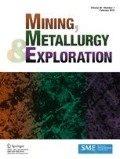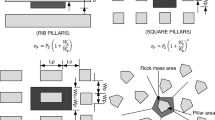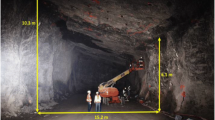Abstract
Pillar stability continues to be a significant concern in multiple-level mining conditions, particularly for deep mines when pillars are not stacked or the thickness of interburden between mining levels is thin. The National Institute for Occupational Safety and Health (NIOSH) is currently conducting research to investigate the stability of pillars in multiple-level limestone mines. In this study, FLAC3D models were created to investigate the effect of interburden thickness, the degree of pillar offset between mining levels, and in situ stress conditions on pillar stability at various depths of cover. The FLAC3D models were validated through in situ monitoring that was conducted at a multiple-level stone mine. The critical interburden thickness required to minimize the interaction between the mining levels on top-level pillar stability was explored, where the top level mine was developed first followed by the bottom level mine.
The model results showed that there is an interaction between numerous factors that control the stability of pillars in multiple-level conditions. A combination of these factors may lead to various degrees of pillar instabilities. The highest degree of local pillar instability occurred when pillar overlap ranges between 10 and 70%. On the contrary, the highest degree of stability occurs when the pillars are stacked, the underlying assumption is that the interburden between mining levels is elastic (never fails). Generally, for depths of cover investigated in this study, the stability of top-level pillars shallower than 100 m (328 ft) or with interburden thicknesses greater than 1.33 times the roof span—16 m (52.4 ft) in this study—does not appear significantly impacted by pillar offset. The results of this study improve understanding of multiple-level interactions and advances the ultimate goal of reducing the risk of pillar instability in underground stone mines.












Similar content being viewed by others
References
American Society for Testing Materials (ASTM), “Standard test method for compressive strength and elastic moduli of intact rock core specimens under varying states of stress and temperatures,” ASTM D 7012-04 Methods A, C and D, ASTM, West Conshohocken, PA, 1429-1436
Esterhuizen GS, Murphy MM (2018) Mining Product: S-Pillar - Software for Stone Mine Pillar Design Version 1.2. Pittsburgh, PA: U.S. Department of Health and Human Services, Public Health Service, Centers for Disease Control and Prevention, National Institute for Occupational Safety and Health, https://www.cdc.gov/niosh/mining/works/coversheet1817.html
Esterhuizen GS, Dolinar DR, Ellenberger JL, Prosser LJ (2011) Pillar and roof span design guidelines for underground stone mines. Department of Health and Human Services, Public Health Service, Centers for Disease Control and Prevention, National Institute for Occupational Safety and Health, DHHS (NIOSH) Publication No. 2011–171, IC 9526, https://www.cdc.gov/niosh/mining/UserFiles/works/pdfs/2011-171.pdf
Esterhuizen GS, Ellenberger JL (2007) Effects of weak bands on pillar stability in stone mines: field observations and numerical model assessment. In: Proceedings of the 26th International Conference on Ground Control in Mining, Morgantown, WV: West Virginia University, 320–326
Haycocks C, Zhou Y (1990) Multiple-seam mining: a state-of-the-art review. In: Proceedings of the Ninth International Conference on Ground Control in Mining, Morgantown, WV: West Virginia University, 1990, 1–11
Hoek E, Brown ET (2018) The Hoek-Brown failure criterion and GSI – 2018 edition. J Rock Mech Geotech Eng. https://doi.org/10.1016/j.jrmge.2018.08.00
Hoek E, Diederichs MS (2006) Empirical estimation of rock mass modulus. Int J Rock Mech Min Sci 43(2):203–2015
Hsiung SM, Peng SS (1987) Design guidelines for multiple-seam mining, Part II. Coal Mine Process States, vol. 24, no. 10
Iannacchione T (1999) Analysis of pillar design practices and techniques for U.S. limestone mines. Trans Inst Min Metall (sect. A: Min. Industry), September–December 108: A152– A160
Itasca Consulting Group (2018) Fast Lagrangian analysis of continua in 3dimensions. Itasca Consulting Group: Minneapolis, MN, USA
Lunder PJ, Pakalnis RC (1997) Determination of the strength of hard-rock mine pillars. Bull Can Inst Min Metall 90(1013):51–55
Mark C, Tuchman RJ (2007) Proceedings: new technology for ground control in multiple-seam mining. Department of Health and Human Services, Public Health Service, Centers for Disease Control and Prevention, National Institute for Occupational Safety and Health, DHHS (NIOSH) Publication No. 2007–110, Information Circular 9495.
McNeel R, others (2010) Rhinoceros 3D, Version 6.0. Robert McNeel & Associates, Seattle, WA
Murphy M, Esterhuizen GS, Slaker B (2020) Addressing stone mine pillar design with the NIOSH S-Pillar software. SME Annual Meeting, Feb. 24 - 27, Phoenix, AZ
Newman C, Newman D, Dupuy R (2020) Development of a multiple level underground limestone mine from geology through mine planning. Int J Min Sci Technol 30(1):63–67. https://doi.org/10.1016/j.ijmst.2019.12.007
Newman D (2017) Roof control pillar stability and ground control issues in underground stone mines. Min Eng 69(8):53–58. https://doi.org/10.19150/me.7685
Newman DA, DeCinque J, Dafferner A (2001) The integration of geology and engineering in ground control and mine planning for a multi-level underground limestone quarry. In: Proceedings of the 20th International Conference on Ground Control in Mining, Morgantown, WV: West Virginia University, 7–9 August 2012
Rashed G, Slaker BA (2020) A study of the interburden stability in multilevel limestone mines using FLAC3D models. Paper presented at the 54th U.S. Rock Mechanics/Geomechanics Symposium, physical event cancelled. vol. 64, p. 75. ISBN: 978–0–9794975–5–1
Slaker B, Murphy M, Rashed G (2020) Monitoring of multiple-level stress interaction at two underground limestone mines. Min, Metall Explor. https://doi.org/10.1007/s42461-020-00345-z
Author information
Authors and Affiliations
Corresponding author
Ethics declarations
Disclaimer
The findings and conclusions in this report are those of the authors and do not necessarily represent the official position of the National Institute for Occupational Safety and Health. Mention of any company or product does not constitute endorsement by NIOSH.
Additional information
Publisher's Note
Springer Nature remains neutral with regard to jurisdictional claims in published maps and institutional affiliations.
Data from this manuscript have been presented at the 40th SME International Conference on Ground Control in Mining, July 27–28, 2021.
Rights and permissions
About this article
Cite this article
Rashed, G., Slaker, B. & Murphy, M. Exploration of Limestone Pillar Stability in Multiple-Level Mining Conditions Using Numerical Models. Mining, Metallurgy & Exploration 39, 1887–1897 (2022). https://doi.org/10.1007/s42461-022-00655-4
Received:
Accepted:
Published:
Issue Date:
DOI: https://doi.org/10.1007/s42461-022-00655-4




